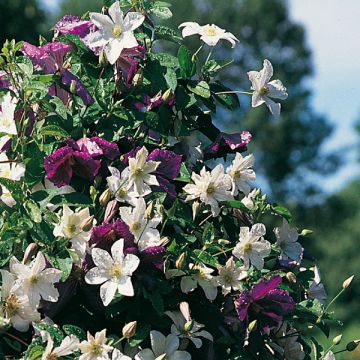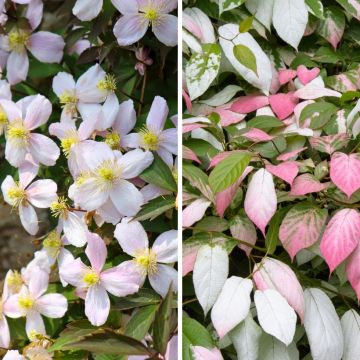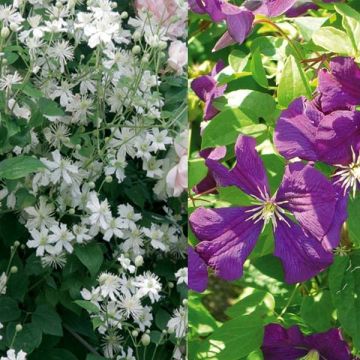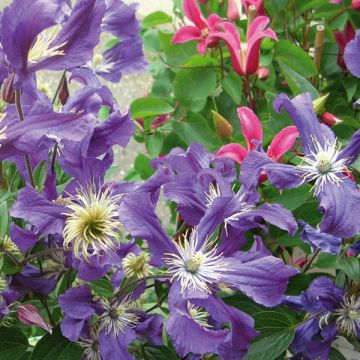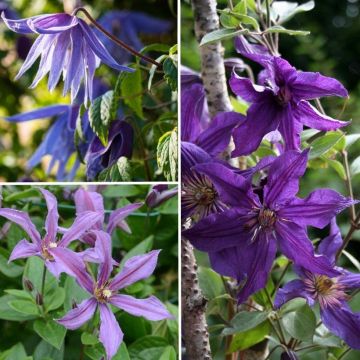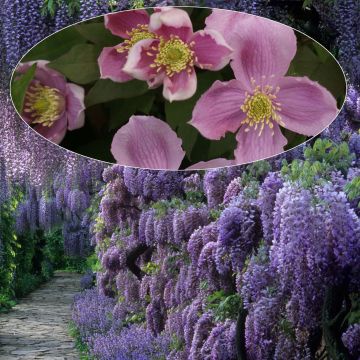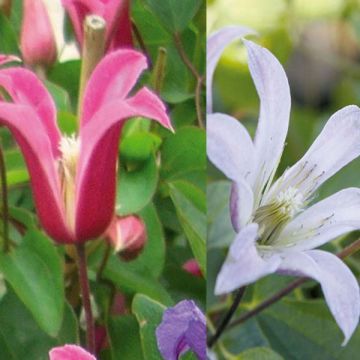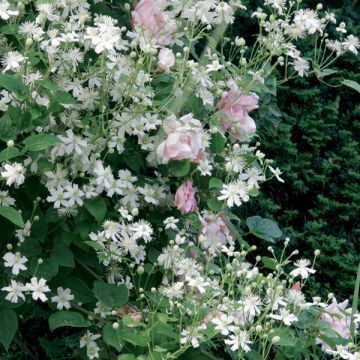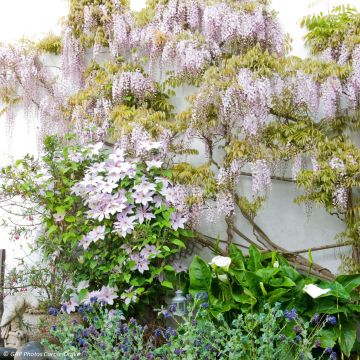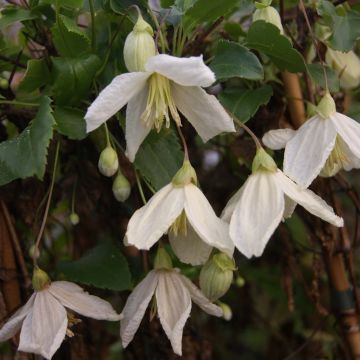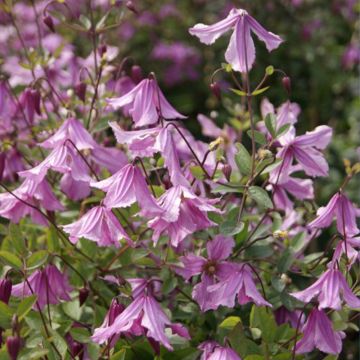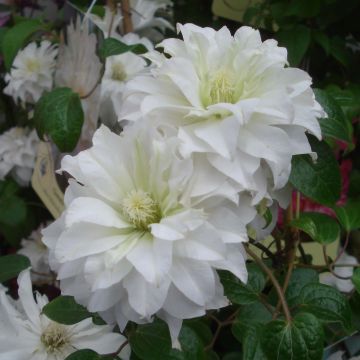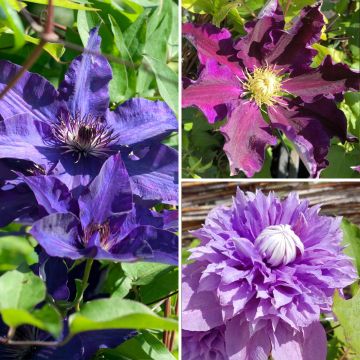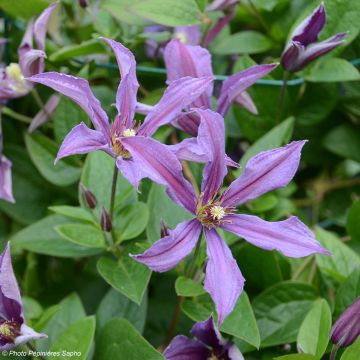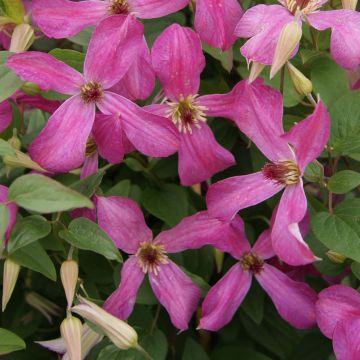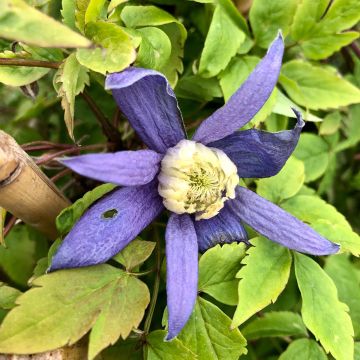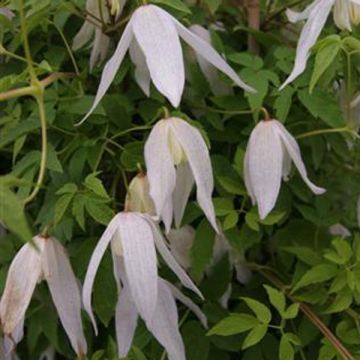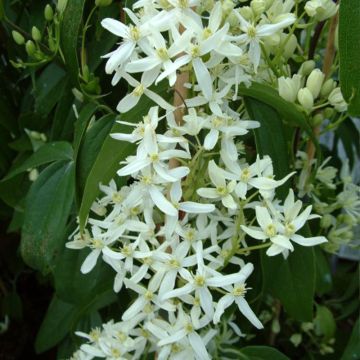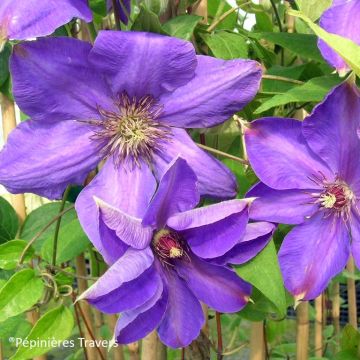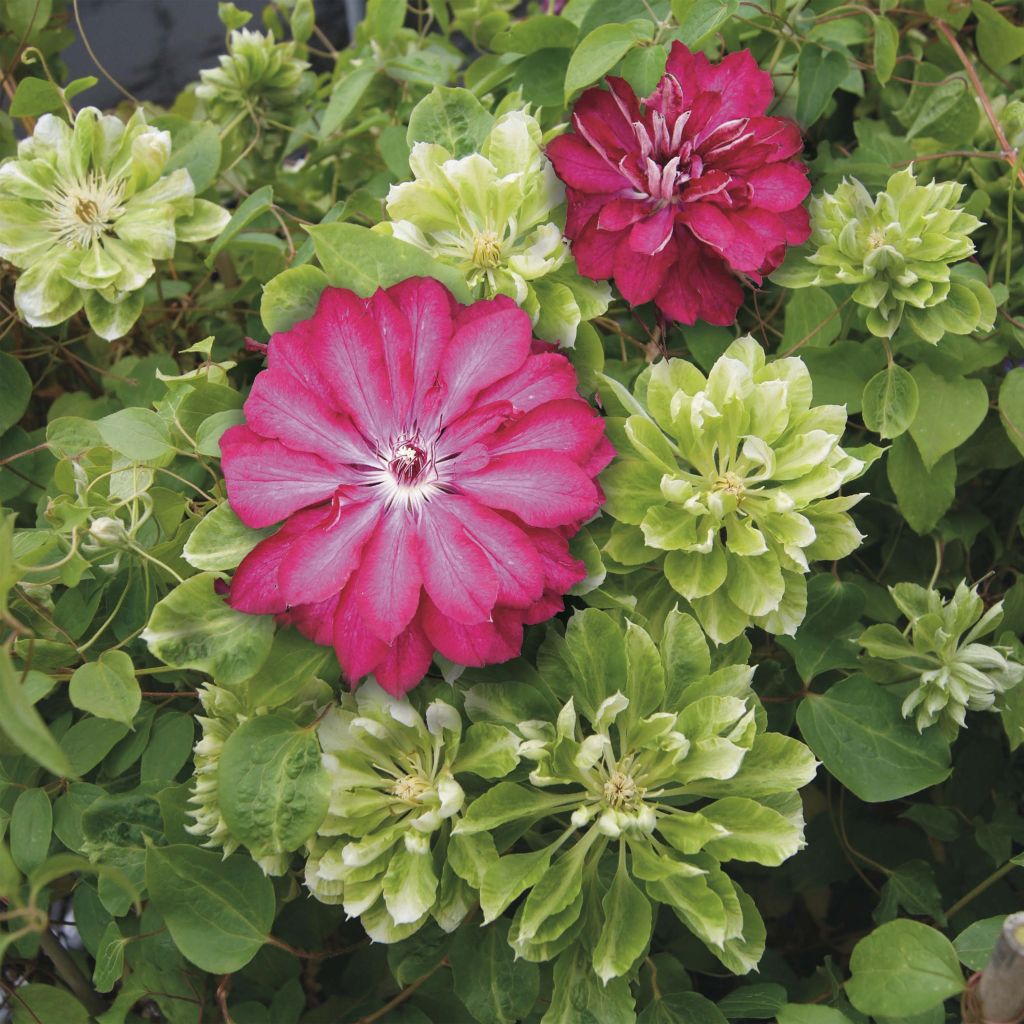

Passionate Clematis Collection
Passionate Clematis Collection
Clematis Red Passion®, Green Passion®
Perfect
Martine L., 24/09/2018
This item cannot be shipped to the selected country
Delivery charge from €5.90
More information
Schedule delivery date,
and select date in basket
This plant carries a 6 months recovery warranty
More information
We guarantee the quality of our plants for a full growing cycle, and will replace at our expense any plant that fails to recover under normal climatic and planting conditions.
From €5.90 for pickup delivery and €6.90 for home delivery
Express home delivery from €8.90.
Does this plant fit my garden?
Set up your Plantfit profile →
Collection items (2 plants)
Description
The new 'Red Passion' and 'Green Passion' clematis are brought together in this lovely duo with the appearance of an ancient tapestry. The large double flowers, with rich shades of pink in the sumptuous Red Passion, will be tempered by the pistachio green of the unusual, fluffy and tousled corollas of the tender Green Passion. Their flowering takes place simultaneously, first in spring and then again in autumn, on small lianas of the same stature, well suited to pot cultivation and small spaces. Give your garden, terrace or balcony an unexpected and charming decoration by combining these two amazing Passion clematis!
Clematis belong to the Ranunculaceae family. They can be found in both hemispheres, especially in Europe, the Himalayas, China, Australia, and North and Central America. The 'Green Passion' and Red Passion varieties, obtained in the Netherlands and introduced in 2016 and 2017, are perfectly perennial and hardy plants, semi-woody and climbing, which will reach 2 to 3m (7 to 10ft) in height, with a minimum spread of 1.25m (4ft). They belong to the patens group of clematis.
These two clematis bear double flowers, with a diameter of 12 to 15cm (5 to 6in), appearing on the previous year's wood in spring, from April to June, and then again on the shoots of the year, from late summer to autumn. The flowers are sometimes semi-double in late summer. They are solitary or grouped in cymes and particularly abundant. They are erect and have a multitude of tepals, with a tender green color and silky reverse that truly resemble leaves for Green Passion, and a red-pink color with a lighter base and silky reverse for Red Passion, these two colors complementing each other perfectly. The flowering is followed by decorative feathered silvery gray fruits that persist until winter. The leaves, deciduous, are divided into small rounded leaflets, glabrous, of a medium green color. This clematis clings to the support or host plant through petioles transformed into tendrils.
Plant your clematis alongside your climbing roses or lianas to extend the flowering of your walls and pergolas until the end of summer. It is a diverse genus, with clematis available in all colours, shapes, and sizes. Take advantage of their easy cultivation to give your garden a romantic and bohemian touch. 'Green Passion' and 'Red Passion', which love to climb in bushes, form a very successful marriage in the garden, but also in a container on the terrace or balcony. Plant these two adorable little lianas near a cotinus, a white lilac, a mock orange, or a Photinia, whose red and green foliage displays the same harmonious and complementary hues. Create unusual spring bouquets by picking a few branches laden with flowers, mixed with pink or purple peonies, white or black tulips, "red" or white irises, and many other garden flowers.
Report an error about the product description
Plant habit
Flowering
Foliage
Botanical data
Clematis
Red Passion®, Green Passion®
Renonculaceae
Cultivar or hybrid
Other Clematis collections
Planting and care
The 'Passion' Clematis will appreciate a sunny or lightly shaded position near a tree. Plant it in a fertile, humus-rich soil, especially well-drained; shading the roots and base of the stem (with a flat tile, for example). In general, the clematis wilts in overly wet soil and hot weather, falling victim to a terrible disease commonly known as wilt. Plant it by covering the root ball with 3 cm (1in) of soil, in soil worked to a depth of 20 cm (8in), lightened with good compost and coarse sand. After planting, cut back the clematis stems to about 30 cm (12in) from the base above a nice pair of buds. In the first few weeks, water regularly. However, be careful not to let the water stagnate as this can cause a fungus to develop at the neck. Mulch all clematis in February with garden compost or well-rotted manure, avoiding direct contact with the stems. Train the stems, without squeezing them, until the plant grips onto them itself. Clematis also like to grow freely on neighboring plants. Remove dead or weak stems in March, before the vegetation resumes, and cut back all others above 2 healthy buds. They will produce secondary stems that will bear lateral shoots flowering in May. Remove faded flowers. Young shoots will flower later in the season.
After a few years, cover the base of your climbing clematis with a small mound of soil, to reduce the risk of wilt while promoting the emergence of vigorous shoots from the base. Voles and grey worms can attack clematis and devour the stems. Aphids and greenhouse whiteflies are also potential parasites of clematis.
Planting period
Intended location
Care
-
, onOrder confirmed
Reply from on Promesse de fleurs
Clematis
Haven't found what you were looking for?
Hardiness is the lowest winter temperature a plant can endure without suffering serious damage or even dying. However, hardiness is affected by location (a sheltered area, such as a patio), protection (winter cover) and soil type (hardiness is improved by well-drained soil).

Photo Sharing Terms & Conditions
In order to encourage gardeners to interact and share their experiences, Promesse de fleurs offers various media enabling content to be uploaded onto its Site - in particular via the ‘Photo sharing’ module.
The User agrees to refrain from:
- Posting any content that is illegal, prejudicial, insulting, racist, inciteful to hatred, revisionist, contrary to public decency, that infringes on privacy or on the privacy rights of third parties, in particular the publicity rights of persons and goods, intellectual property rights, or the right to privacy.
- Submitting content on behalf of a third party;
- Impersonate the identity of a third party and/or publish any personal information about a third party;
In general, the User undertakes to refrain from any unethical behaviour.
All Content (in particular text, comments, files, images, photos, videos, creative works, etc.), which may be subject to property or intellectual property rights, image or other private rights, shall remain the property of the User, subject to the limited rights granted by the terms of the licence granted by Promesse de fleurs as stated below. Users are at liberty to publish or not to publish such Content on the Site, notably via the ‘Photo Sharing’ facility, and accept that this Content shall be made public and freely accessible, notably on the Internet.
Users further acknowledge, undertake to have ,and guarantee that they hold all necessary rights and permissions to publish such material on the Site, in particular with regard to the legislation in force pertaining to any privacy, property, intellectual property, image, or contractual rights, or rights of any other nature. By publishing such Content on the Site, Users acknowledge accepting full liability as publishers of the Content within the meaning of the law, and grant Promesse de fleurs, free of charge, an inclusive, worldwide licence for the said Content for the entire duration of its publication, including all reproduction, representation, up/downloading, displaying, performing, transmission, and storage rights.
Users also grant permission for their name to be linked to the Content and accept that this link may not always be made available.
By engaging in posting material, Users consent to their Content becoming automatically accessible on the Internet, in particular on other sites and/or blogs and/or web pages of the Promesse de fleurs site, including in particular social pages and the Promesse de fleurs catalogue.
Users may secure the removal of entrusted content free of charge by issuing a simple request via our contact form.
The flowering period indicated on our website applies to countries and regions located in USDA zone 8 (France, the United Kingdom, Ireland, the Netherlands, etc.)
It will vary according to where you live:
- In zones 9 to 10 (Italy, Spain, Greece, etc.), flowering will occur about 2 to 4 weeks earlier.
- In zones 6 to 7 (Germany, Poland, Slovenia, and lower mountainous regions), flowering will be delayed by 2 to 3 weeks.
- In zone 5 (Central Europe, Scandinavia), blooming will be delayed by 3 to 5 weeks.
In temperate climates, pruning of spring-flowering shrubs (forsythia, spireas, etc.) should be done just after flowering.
Pruning of summer-flowering shrubs (Indian Lilac, Perovskia, etc.) can be done in winter or spring.
In cold regions as well as with frost-sensitive plants, avoid pruning too early when severe frosts may still occur.
The planting period indicated on our website applies to countries and regions located in USDA zone 8 (France, United Kingdom, Ireland, Netherlands).
It will vary according to where you live:
- In Mediterranean zones (Marseille, Madrid, Milan, etc.), autumn and winter are the best planting periods.
- In continental zones (Strasbourg, Munich, Vienna, etc.), delay planting by 2 to 3 weeks in spring and bring it forward by 2 to 4 weeks in autumn.
- In mountainous regions (the Alps, Pyrenees, Carpathians, etc.), it is best to plant in late spring (May-June) or late summer (August-September).
The harvesting period indicated on our website applies to countries and regions in USDA zone 8 (France, England, Ireland, the Netherlands).
In colder areas (Scandinavia, Poland, Austria...) fruit and vegetable harvests are likely to be delayed by 3-4 weeks.
In warmer areas (Italy, Spain, Greece, etc.), harvesting will probably take place earlier, depending on weather conditions.
The sowing periods indicated on our website apply to countries and regions within USDA Zone 8 (France, UK, Ireland, Netherlands).
In colder areas (Scandinavia, Poland, Austria...), delay any outdoor sowing by 3-4 weeks, or sow under glass.
In warmer climes (Italy, Spain, Greece, etc.), bring outdoor sowing forward by a few weeks.




































